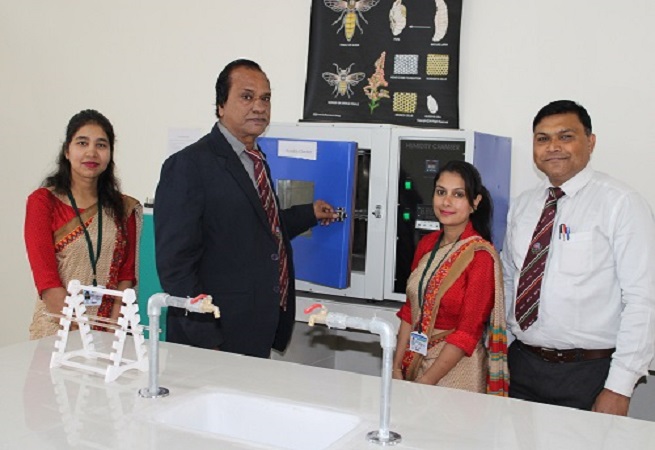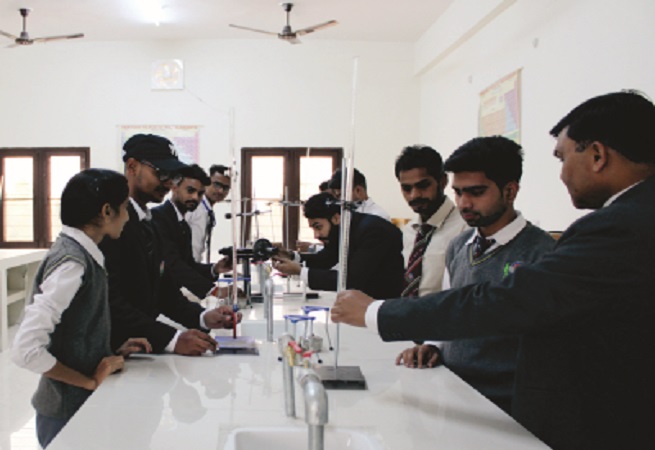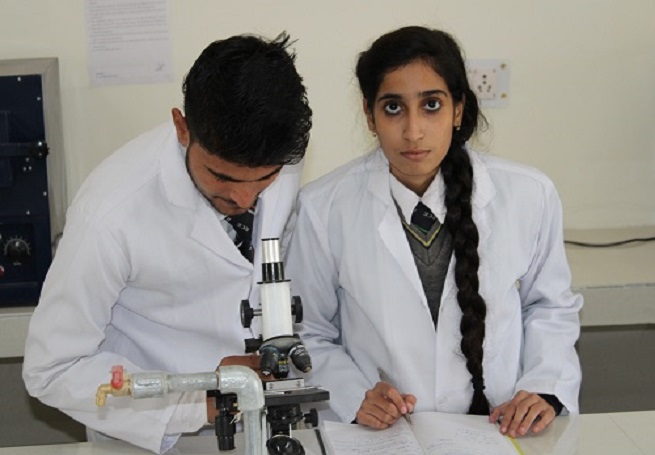Pharmacy
Laboratory
PHARMACEUTICS-I LAB
Pharmaceutics is designed to fundamental knowledge on the preparatory pharmacy with arts and science of preparing the different conventional dosage form. It is used to understand the basics of different dosage forms, pharmaceutical incompatibilities and pharmaceutical calculations..


Preapare and submit Glycero gelatin suppository Preapare and submit Coca butter suppository Preapare and submit zinc oxide suppository 9. Semisolids Preapare and submit Sulphur ointment Preapare and submit non staining-iodine ointment with methyl salicylate Preapare and submit carbopol gel 10. Gargles and mouthwash Preapare and submit iodine gargle Preapare and submit chlorhexidine mouthwash
| S.NO | NAME OF EXPERIMENT | OBJECTIVE |
|---|---|---|
| 01 | Syrups. | Preapare and submit Syrup IP’ 66 Prepare and submit compound syrup of ferrous phosphate BPC’68 |
| 02 | Elixirs | Preapare and submit piperazine citrate elixir. Preapare and submit paracetamol pediatric elixir. |
| 03 | Linctus | Preapare and submit terpin hydrate linctus IP’66. Preapare and submit iodine throat paint (mandles paint). |
| 04 | Solutions | Preapare and submit strong solution of ammonium acetate Preapare and submit cresol with soap solution. |
| 05 | Suspensions | Preapare and submit Calamine lotion Preapare and submit Magnesium hydroxide mixture Preapare and submit Aluminium hydroxide gel |
| 06 | Emulsions | Preapare and submit Turpentine liniment Preapare and submit liquid paraffin emulsion |
| 07 | Powder and granules | Preapare and submit ORS powder (WHO) Preapare and submit efferevescent granules Preapare and submit dusting powder Preapare and submit divided powder . |
| 08 | Suppositories | Preapare and submit Glycero gelatin suppository Preapare and submit Coca butter suppository Preapare and submit zinc oxide suppository. |
| 09 | Semisolids. | Preapare and submit Sulphur ointment Preapare and submit non staining-iodine ointment with methyl salicylate Preapare and submit carbopol gel. |
| 10 | Gargles and mouthwash. | Preapare and submit iodine gargle Preapare and submit chlorhexidine mouthwash |
PHARMACEUTICAL ANALYSIS LAB
Pharmaceutical analysis is the branch of practical chemistry that involves a series of process for identification, determination, quantification and purification of a substance, separation of the components of a solution or mixture or determination of structure of chemical compounds.


| S.NO | NAME OF EXPERIMENT | OBJECTIVE |
|---|---|---|
| 01 | Limit test | Perform limit test for Chloride Perform limit test for Sulphate Perform limit test for Iron. |
| 02 | Standardization | Preparation and standardization of Sodium hydroxide Preparation and standardization of Sulphuric acid Preparation and standardization of Sodium thiosulfate Preparation and standardization of Permanganate. |
| 03 | Assay | Perform the assay of ammonium chloride by acid base titration Perform the assay of ferrous sulphate by Cerimetry Perform the assay of copper sulfate by Iodometry Perform the assay of calcium gluconate by complexometry Perform the assay of hydrogen peroxide by Permanganometry Perform the assay of Sodium benzoate by non-aqueous titration Perform the assay of sodium chloride by precipitation titration |
| 04 | Colorimetry | Estimation of dextrose by colorimetry |
| 05 | Colorimetry | Estimation of sulfanilamide by colorimetry |
| 06 | UV Spectroscopy | Simultaneous estimation of ibuprofen and paracetamol by UV Spectroscopy Assay of paracetamol by UV Spectrophotometry. |
| 07 | Fluorimetry | Estimation of quinine sulphate by fluorimetry |
| 08 | Flame photometry | Determination of sodium by flame photometry |
| 09 | Paper chromatography | Separation of amino acids by paper chromatography |
PHARMACOLOGY LAB
Pharmacology is the study of the substances which interact with living system by activating or inhibiting normal body processes. In this lab we study about the drug action and analyze various pharmacodynamics and pharmacokinetic parameters the drug.


| S.NO | NAME OF EXPERIMENT | OBJECTIVE |
|---|---|---|
| 01 | Introduction | Introduction to experimental Pharmacology. |
| 02 | Instruments | Commonly used instruments in experimental pharmacology |
| 03 | Laboratory Animals | Study of common laboratory animals. |
| 04 | CPCSEA guidelines | Maintenance of laboratory animals as per CPCSEA guidelines. |
| 05 | Routes of administration | Study of different routes of drugs administration in mice/rats. |
| 06 | Effect of Drug | Effect of drugs on ciliary motility of frog oesophagus |
| 07 | Effect of Drug | Effect of drugs on rabbit eye. |
| 08 | Rotarod | Effects of skeletal muscle relaxants using rota-rod apparatus. |
| 09 | Actophotometer | Effect of drugs on locomotor activity using actophotometer. |
| 10 | Anti-catatonic activity | Study of stereotype and anti-catatonic activity of drugs on rats/mice. |
| 11 | Anxiolytic activity | Study of anxiolytic activity of drugs using rats/mice. |
| 12 | Local anaesthetics | Study of local anaesthetics by different methods. |
| 13 | Physiological salt solution | Introduction to in-vitro pharmacology and physiological salt solutions. |
| 14 | Effect of drug | Effect of drugs on isolated frog heart. |
| 15 | Blood pressure | Effects of drugs on blood pressure and heart rate of dog. |
| 16 | Matching method | Bioassay of histamine using guinea pig ileum by matching method. |
| 17 | Interpolation method | Bioassay of oxytocin using rat uterine horn by interpolation method.. |
BIOCHEMISTRY LAB
Biochemistry deals with complete understanding of the molecular levels of the chemical process associated with living cells. The scope of the subject is providing biochemical facts and the principles to understand metabolism of nutrient molecules in physiological and pathological conditions.


| S.NO | NAME OF EXPERIMENT | OBJECTIVE |
|---|---|---|
| 01 | Carbohydrate | Qualitative analysis of carbohydrates (Glucose, Fructose, Lactose, Maltose, Sucrose and Starch) |
| 02 | Proteins | Identification test for Proteins (Albumin, Casein) |
| 03 | Qualitative analysis | Quantitative analysis of reducing sugars (DNSA method) and Proteins (Biuret method) Qualitative analysis of urine for abnormal constituents |
| 04 | Determination | Determination of blood creatinine Determination of blood sugar Determination of serum total cholesterol |
| 05 | Preparation | Preparation of buffer solution and measurement of pH |
| 06 | Starch | Study of enzymatic hydrolysis of starch |
| 07 | Determination | Determination of salivary amylase activity |
PHARMACEUTICAL INORGANIC CHEMISTRY LAB
Inorganic chemistry deals with the synthesis and behavior of inorganic and organometallic compounds.


| S.NO | NAME OF EXPERIMENT | OBJECTIVE |
|---|---|---|
| 01 | Limit test | Perform the limit test for chlorides and sulphates Perform the modified limit test for chlorides and sulphates Perform the limit test for iron Perform the limit test for heavy metals Perform the limit test for lead Perform the limit test for arsenic |
| 02 | Identification test | Perform identification test for Magnesium hydroxide Perform identification test for Ferrous sulphate Perform identification test for Sodium bicarbonate Perform identification test for Calcium gluconate Perform identification test for Copper sulphate |
| 03 | Preparation | Perform the preparation of boric acid Perform the preparation of potash alum Perform the preparation ferrous sulphate |
| 04 | Test for purity | Determination of potassium iodate and iodine in potassium iodide |
Human Anatomy and Physiology Lab
Anatomy is the branch of science which deals with the study of internal structures and the term physiology is a science that deals with the study of the functions of the various parts of an organism or human body.
One has to study anatomy in combination with physiology and vice-versa. Knowledge of one without the other makes the study incomplete. The anatomy and structure of an organ depends upon the type of function (physiology) it performs and the function is carried out according to the structural organization of a particular part or an organ of the body. In this lab we study about various anatomical and physiological parameters of the human body.


| S.NO | NAME OF EXPERIMENT | OBJECTIVE |
|---|---|---|
| 01 | Microscope | Study of compound microscope |
| 02 | Histology | Microscopic study of epithelial and connective tissue |
| 03 | Histology | Microscopic study of muscular and nervous tissue |
| 04 | Skeletal system | Identification of axial bones |
| 05 | Skeletal system | Identification of appendicular bones |
| 06 | Hematology | Introduction to hemocytometry |
| 07 | Hematology | Enumeration of white blood cell (WBC) count |
| 08 | Hematology | Enumeration of total red blood corpuscles (RBC) count |
| 09 | Hematology | Determination of bleeding time |
| 10 | Hematology | Determination of clotting time |
| 11 | Hematology | Estimation of hemoglobin content |
| 12 | Hematology | Determination of blood group |
| 13 | Hematology | Determination of erythrocyte sedimentation rate (ESR) |
| 14 | Physiology | Determination of heart rate and pulse rate |
| 15 | Physiology | Recording of blood pressure |
| 16 | Physiology | Recording of body temperature |
| 17 | Sense organs | Examine the different types of taste |
| 18 | Sense organs | Demonstrate the visual acuity |
| 19 | Sense organs | Demonstrate the reflex activity |
| 20 | Sense organs | Demonstrate positive and negative feedback mechanism |
REMEDIAL BIOLOGY LAB
Remedial biology is used to learn and understand the components of living world, structure and functional system of plant and animal kingdom. It is used to understand the basic components of anatomy and physiology of plant.


| S.NO | NAME OF EXPERIMENT | OBJECTIVE |
|---|---|---|
| 01 | Introduction | Study the care, use and handling of microscope Understand technique of section cutting, staining and mounting |
| 02 | Cell | Study about cell and its inclusions |
| 03 | Plant | Study different modification of leaf Study different modification of stem Study different modification of root Cut a transverse section of a given dicot stem and make a temporary stained mount to study its structure. |
| 04 | Animal tissue | Study the microscopic structure of animal tissue from permanent slide. |
| 05 | Skeletal system | Study the human skeletal system |
| 06 | Computer model | Study of frog by using computer models |
| 07 | Blood | Determination of blood group Determination of blood pressure Determination of tidal volume |
Pharmaceutical Microbiology Lab
Pharmaceutical Microbiology deals with the study of microorganisms especially for the production of alcohol, antibiotics, vaccines, vitamins enzymes etc.. the identification, cultivation and preservation of various microorganisms is thought to students along with the knowledge of various methods & importance of sterilization. Sterility testing is an another elite part and process of pharmaceutical Microbiology Lab.


| S.NO | NAME OF EXPERIMENT | OBJECTIVE |
|---|---|---|
| 01 | Sterilization | Sterilization of various glassware equipment and culture media |
| 02 | Culture Technique | Bacteria and fungus growing in enriched culture media |
| 03 | Staining Methods | Practical demonstration of Simple, Gram & Acid fast staining.. |
| 04 | Multiple streak plate technique | Isolation of pure culture of micro organisms |
| 05 | Antibiotic Assay | Microbiological assay by cup plate method |
| 06 | Motility determination | Through Hanging drop method |
| 07 | Sterility testing | Pharmaceuticals sterility testing |
| 08 | Bacteriological Analysis | Various Fluids (Water) bacteriological analysis. |
Pharmacognosy & Phytochemicals
The subject involves the fundamental of pharmacognosy like scope, classification of crude drug their identification and evaluation, phytochemical present in them and there medicinal properties.


| S.NO | NAME OF EXPERIMENT | OBJECTIVE |
|---|---|---|
| 01 | Analysis of crude drugs | Analyze the crude drugs by chemical tests of acacia, castor oil, honey, gelatin, agar etc. |
| 02 | Stomata Index | Determination of stomata numbers |
| 03 | Palisade Ratio | Determination of vein islet no. & Palisade ratio |
| 04 | Micrometer | Determination of size of starch grains, calcium oxalate crystals by eye piece micrometer |
| 05 | Stage Micrometer | Determination of fiber length and weight. |
| 06 | Lycopodium spore method | Determination of no. Of starch grains by lycopodium spore methods. |
| 07 | Muffle furnace | Determination of Ash value |
| 08 | Soxhlet Apparatus | Determination of extractive value of crude drugs. |
Instrumental Method of Analysis Lab: (Instrumentation Room)
The lab deals with application of instrumentals methods in qualitative and quantitative analysis of drugs. This subject is designed to impart a fundamental knowledge on the principles and instrumentation of spectroscopic and chromatographic technique. This also emphasis on theoretical and practical knowledge on modern analytical instruments that are used for drug testing.


| S.NO | NAME OF EXPERIMENT | OBJECTIVE |
|---|---|---|
| 01 | Mass Spectroscopy | Determination of absorption maxima & effect of solvents. |
| 02 | Colorimetry | Estimation of Sulfanilamide by colorimetry |
| 03 | UV Spectroscopy | Estimation of Ibuprofen and paracetamol by UV spectroscopy |
| 04 | Fluorimetory | Estimation of quinine sulphate by fluorimetory |
| 05 | Flame Photometry | Determination of sodium and potassium by flame photometry |
| 06 | Nephlo turbidometry | Extermination of Chloride and sulphate by nephlo turbidometry |
| 07 | Chromatography | Seperation Technique |
| 08 | HPLC | Demonstration of Equipment |
| 09 | Gas chromatography | Demonstration Experiment |
Industrial Pharmacy
The lab enables the students to understand and appreciate the influence of pharmaceutical additives and various pharmaceutical dosage forms on the performance of the drug product.


| S.NO | NAME OF EXPERIMENT | OBJECTIVE |
|---|---|---|
| 01 | Preformulation | Perform preformulation study of drugs such as paracetamol, aspirin etc. |
| 02 | Paracetamol | Preparation and Evaluation of Paracetamol tablet |
| 03 | Aspirin | Preparation and Evaluation of Aspirin tablet |
| 04 | Tetracycline | Preparation and Evaluation of Tetracycline capsules. |
| 05 | Quality Control testing | QC Testing of Capsules and Tablets as per IP |
| 06 | Ophthalmic Formulation | Preparation of Eye Drops and ointment |
Pharmaceutical Engineering Lab
This lab impart fundamental knowledge on the art and science of various unit operation used in pharmaceutical industry.


| S.NO | NAME OF EXPERIMENT | OBJECTIVE |
|---|---|---|
| 01 | Radiation Constant | Determination of radiation constant of brass, Iron, Unpainted and painted glass |
| 02 | Steam Distillation | Efficacy calculation of steam distillation |
| 03 | Heat Process | Heat transfer coefficient determination by heat ex changer |
| 04 | Dew point Method | Determination of Air humidity |
| 05 | Engineering Drawing | ED and working of Pharmaceutical Machinery such as rotatory tablet machine, fluid energy mill etc. |
| 06 | Size reduction | Verification of law of size reduction using ball mill |
| 07 | Filtration Process | Study of factors affecting and rate of filtration and evaporation. |
| 08 | Double cone blender | Calculation of uniformity index for given sample DCB. |



